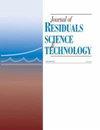s -甲草胺的降解及其对菜地土壤酶和微生物群落的影响
引用次数: 2
摘要
s -甲草胺是一种很有前途的甲草胺替代品。然而,中国蔬菜田广泛使用s -甲草胺作为除草剂,引起了人们对其环境命运的担忧。研究了温度、相对湿度和PH对s -甲草胺在蔬菜土壤中降解速率的影响。s -异甲草胺的降解速率随温度和相对湿度的升高而升高,酸性或碱性PH均有利于s -异甲草胺的降解。在此条件下,s -异甲草胺的降解符合一级动力学,在5-35℃条件下,半衰期(T-1/2)为12.18 ~ 70.71 d,在RH 30-90%条件下,半衰期为27.28 ~ 53.72 d;pH 6 ~ 8时29.62 ~ 19.69 d。高有机质土壤过氧化氢酶、脱氢酶、脲酶和纤维素酶对s -甲草胺的响应较强。PLFA谱图显示,放线菌、真菌和细菌等微生物数量在处理后的前14天逐渐增加,在处理后的14 ~ 28天逐渐减少。所有s -甲草胺处理均引起好氧菌和厌氧菌的增加。13.9 mg/kg的高s -甲草胺浓度可在前2周引起显著变化,刺激整个土壤微生物群落的生长。这些发现可能对菜田中s -甲草胺残留的命运具有实际意义。考虑环境因素,特别是温度、相对湿度和pH值,结合s -甲草胺的适当施用剂量,达到满意的除草效果,减少径流,尽量减少对环境质量的影响。本文章由计算机程序翻译,如有差异,请以英文原文为准。
Degradation of S-metolachlor and its Effects on Soil Enzymes and Microbial Communities in Vegetable Field Soil
S-metolachlor is a promising alternative to metolachlor. However, the extensive use of S-metolachlor as herbicide in vegetable fields in China has caused concerns about its environmental fate. Here we investigated the effects of temperature, relative humidity (RH) and PH on the degradation rate of S-metolachlor in vegetable soil. The degradation rates of S-metolachlor increased with increasing temperatures and RH and either acidic or basic PH facilitates S-metolachlor degradation. The degradation of S-metolachlor under these conditions followed the first-order kinetics resulting in the half-lives (T-1/2) ranging from 12.18 d to 70.71 d at 5–35°C, and 27.28 d to 53.72 d at RH 30–90%; and 29.62–19.69 d at pH 6–8. Stronger response of soil enzymes including catalase, dehydrogenase, urease and cellulase to S-metolachlor was detected in soil with high organic matter. PLFA profiles showed that, totally, the microbe populations including actinomycetes, fungi and bacteria increased gradually in the first 14 days after the treatment and decreased from 14d to 28d after the treatment. All the S-metolachlor treatments caused the increase of aerobe and anaerobe. High S-metolachlor concentration, 13.9 mg/kg, could cause significant variation at the first 2 weeks, stimulating growth of the entire soil microbial community. These findings might have practical implications for the fate of S-metolachlor residue in vegetable fields. Environmental factors, especially temperature, relative humidity and pH should be considered in combination with the appropriate application dose of S-metolachlor for achieving satisfactory weed-control efficacy, reducing runoff, and minimizing effects on environmental quality.
求助全文
通过发布文献求助,成功后即可免费获取论文全文。
去求助
来源期刊

Journal of Residuals Science & Technology
环境科学-工程:环境
自引率
0.00%
发文量
0
审稿时长
>36 weeks
期刊介绍:
The international Journal of Residuals Science & Technology (JRST) is a blind-refereed quarterly devoted to conscientious analysis and commentary regarding significant environmental sciences-oriented research and technical management of residuals in the environment. The journal provides a forum for scientific investigations addressing contamination within environmental media of air, water, soil, and biota and also offers studies exploring source, fate, transport, and ecological effects of environmental contamination.
 求助内容:
求助内容: 应助结果提醒方式:
应助结果提醒方式:


